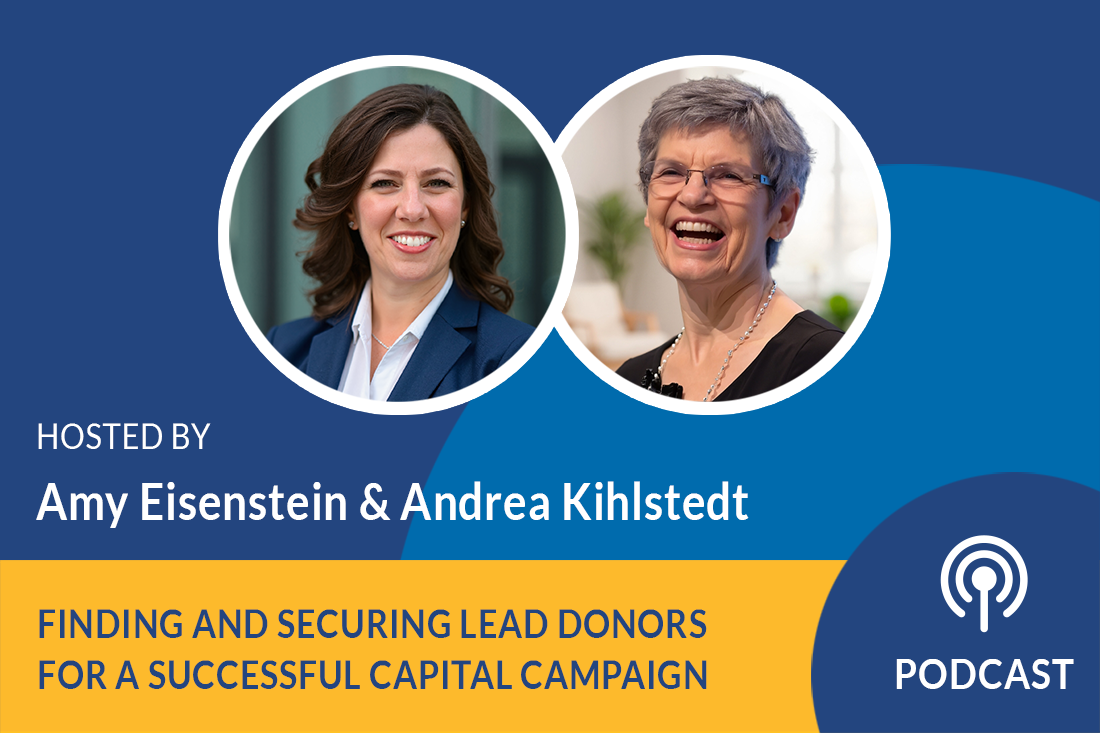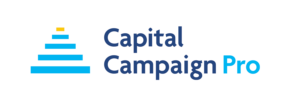Podcast: Should You Start a Capital Campaign During a Recession?

Season 2, Episode 54
If you are worried about a recession, you may be wondering if this is the right time for a capital campaign. Campaign experts Amy Eisenstein and Andrea Kihlstedt discuss the pros and cons of waiting for better times.
Listen Now:
Amy Eisenstein:
Should you start a campaign during a recession? In other words, is THIS a good time to start a campaign? If you’ve been wondering the same kind of thing, you won’t want to miss our strategies on how to conduct a successful campaign, even during a recession.
Hi, I’m Amy Eisenstein, CEO and co-founder of Capital Campaign Pro. And I’m joined today by my friend, colleague and co-pilot of this podcast, Andrea Kihlstedt.
Andrea Kihlstedt:
Hi there, Amy. Thank you. Hi, everybody.
Amy Eisenstein:
If you’re wondering if you should start a campaign in an uncertain economy, you are not alone. And the truth is that people always worry that now, whenever that is, is not a good time to start a campaign. They have a million excuses. The economy, the pandemic, fire, floods, and that’s because campaigns are risky. And the goal you’re trying to reach is probably bigger than any amount you’ve raised before, so it’s scary.
And so that’s why we’re going to share three ways to increase the odds of leading a successful capital campaign, even during a recession. Andrea, why don’t you get us started with the three ways, or at least the first way?
Start by Talking to Your Lead Donors
Andrea Kihlstedt:
Sure. The first way, and it’s such an important strategy, is to talk to your lead donors. Don’t wait until you’re ready to ask them for money, go and talk to them. And one of the classic ways to do that is through a feasibility study. This is really before you go into the campaign proper itself, you want to go and get their advice. You want to tell them why you’re doing a campaign, and get their thoughts on it and find out if they’re going to be willing to help and support your campaign as you move forward.
By talking to them, even in these uncertain times, you’re going to be getting their advice about whether and how to move ahead. They’re going to tell you a little more about their financial situations and their anxieties. And they’re going to give you some sense, you’re going to learn from them how you should proceed.
Amy Eisenstein:
Yes. And honestly, talking to your donors, your lead potential donors, through a formal process like a feasibility study, is really going to give the leaders at your organization, your board members, the confidence they need to be able to proceed with the campaign. Because if your lead donors say, “Yes. My stock portfolio’s down, but I understand how important this campaign is,” then everybody’s going to feel better about proceeding with the campaign.
And you’re going to have talked to those lead donors and say, “Listen, we know the economy’s rough, but that means that our clients need us more than ever. So are you with us?” And if you get affirmation from the majority of your lead donors, you’re going to feel much better and have a much higher chance of success heading into a campaign, even in a rocky economy. Alright, Andrea …. Yeah?
Andrea Kihlstedt:
Amy, we know, we hear all the time, that while development people know they should be talking to their lead donors, they somehow have a hard time doing it until the rubber meets the road.
Amy Eisenstein:
Yes.
Andrea Kihlstedt:
They back away from it, they’re afraid of it. The more anxiety they have, often the less willing they are to go and talk to their lead donors, which is one of the reasons that doing a feasibility study in these times is a perfect way to do it. It becomes a structure that will give you the support you need in actually getting out, having wonderful, robust conversations with your donors. Not asking them for money, but broaching the subject of what this project is and why it matters so much.
Amy Eisenstein:
Yeah. It’s probably important to note that we do a different kind of feasibility study. We’ve adopted a new model of feasibility study, where we actually, at Capital Campaign Pro, train nonprofit leaders to go out and have these important strategic, purposeful conversations with their donors.
Other consultants will go out and talk to your donors for you in a feasibility study, but we think it’s much more effective, much more beneficial to you to go out and have these conversations. Now you’re not going to wing it. These aren’t loose-goosey conversations, they’re highly structured. And you should have the support, guidance and coaching of an experienced campaign consultant. And that is one of the many things we do here at Capital Campaign Pro.
Alright. What’s number two, Andrea? How else should nonprofit leaders think about preparing for a campaign and mitigating their risk in a uncertain economy?
Use an Aspirational “Working” Goal
Andrea Kihlstedt:
One of the amazing things about capital campaign fundraising in particular is that we use what we call a working goal for the campaign — that is that we set aspirational goals right up front. And we test them through a feasibility study, through the whole quiet phase of the campaign when we’re actually raising those largest gifts, but we’re not using a published goal.
We’re not going out into the community and say, “We have a campaign to raise $10 million.” You have a working goal, where you are proceeding as though you are going to be raising $10 million. But as the information becomes clearer, as you see how those gifts are going to come in and how people feel about the project, you will be able to revise that goal.
We often, we always actually, encourage organizations to aim a high so that they’re testing the limits of their fundraising capacity for that capital campaign, but understand that they’ll be able to pull down the goal if they don’t find that those largest gifts they need are going to be available at that time, in this economy. And that there is nothing shameful about doing it. In fact, it is part of the DNA of capital campaign fundraising to use a working goal and to use it for quite some time, until it’s becomes clear how much money you really can raise. And then you publish your goal. That’s sort of a plan B, the eventual published goal is going to be your plan B. “Maybe we can’t do all of this, we have to pare it down.”
Now it also happens that organizations start with a working goal and they find that they can do more than they thought. So their plan B may actually be more assertive, more aggressive, more ambitious than they had imagined, and that really does happen. A second strategy is when you’re heading towards a campaign, use a working goal and understand that you are going to be able to change that without any shame, without any public sentiment of failure in any way, shape or form. The failure in a campaign is shooting so low that you don’t raise all the money that is out there to be raised. That’s failure, not adjusting your goal to fit the reality.
Amy Eisenstein:
Excellent. I think that’s an excellent explanation. People don’t think about using a draft goal. We call it a working goal. It’s like a draft goal through the quiet phase of the campaign, as you’re talking to your lead donors. And you talk to them with the understanding that this is the goal you’re working towards at this time. And when it’s time to go public, six months or a year from now, you will adjust to make sure that the goal is a goal that you can reach.
But in the meantime, the campaign strategy — regardless of the economy or the pandemic or fires or floods or brimstone or whatever — campaign strategy is always to start high with a big vision, and then to scale up or down, depending on how it goes as you go through the campaign. That’s a campaign consultant secret we just revealed.
Anyways, alright, what’s number three? What’s a third strategy?
Extending Your Campaign Timeline
Andrea Kihlstedt:
Number three is this, you can extend your timeline, your capital campaign timeline, sometimes fairly frequently actually. An organization thinks that the campaign is going to take, let’s say, two and a half years. And they get towards the end what they thought would be the end of the quiet phase of the campaign, where they’re raising all of the large gifts, and they find that they still have a lot of lead gifts to solicit, that they haven’t finished doing that. That during that process more lead donors have surfaced, or it’s taken them longer to actually get commitments from their lead donors.
Sometimes, what you thought was going to be two years, ends up extending to three years. There’s no problem with extending the timeline, as long as you have a clear plan of what you’re going to do in that extended timeline. You don’t want to extend the timeline simply because you’re stuck and you don’t have any donors, anymore donors to go to. So you have to look carefully and make sure that you still have people in your pipeline to be going to, that you are clear that you can use that additional time to really be raising some money.
Time by itself, without a plan, without additional ways to raise that money, is simply delay. And eventually your community’s going to be onto you and realize that this is really … That’s failure. You don’t want to be in that position.
Amy Eisenstein:
No, you don’t. That’s true.
Alright, I just want to remind folks, listeners, that if you’ve enjoyed this podcast, I hope you’ll click to follow so that you can learn more. Whenever we post a podcast, you’ll be notified. You can also visit our blog at capitalcampaignpro.com, where we’ve got a lot more content on this topic and more.
So we talked about how to mitigate the risk and go ahead and be brave enough to start a campaign, even in a recession. Number one was talk to your lead donors, and usually that’s done through a formal feasibility study. Now our feasibility study model encourages you, the nonprofit leaders, to go have these important conversations, structured conversations with your donors, to find out what they’re thinking. Whether we’re in a boom or bust market, we want to make sure that our donors are by our sides.
Number two, use a working goal. Through the entire beginning, quiet phase of a campaign, you’re going to use a working goal. You’re going to use, as Andrea said, an aspirational goal. You’re going to aim high. And you’re going to have a plan B, that without any public knowledge or humiliation or disappointment, you can always revert to plan B if you find that your working goal, your aspirational goal, is a little bit too high. And so you need to have your plan B match the reality of the situation.
And number three of course is to extend the timeline, but only if you have donors identified that you’re going to speak to. It’s not extending the timeline indefinitely. Alright. So remember-
Andrea Kihlstedt:
You know, Amy — I’m reminded of the fact that when the pandemic began, in the early stages of COVID, so many organizations wondered whether to continue with their campaign plans… so many.
Amy Eisenstein:
Yeah.
Andrea Kihlstedt:
So many wondered whether to continue with their fundraising. And of course, what we saw is those that decided not to continue, didn’t raise money. And those that decided to continue, did. That’s a really clear message.
Amy Eisenstein:
Yes.
Andrea Kihlstedt:
If you decide you’re not going to move ahead with your fundraising, that for some reason you’re going to use these things as excuses just to sit back and wait, wait until a sunny day, you’re going to wait a very long time while everybody else (or the people who are smart) are actually moving ahead with their fundraising.
We encourage you to move ahead, no matter whether there are locusts or pandemics or —
Amy Eisenstein:
Floods.
Andrea Kihlstedt:
…. recessions or … If you have a real serious and important mission, and people who need more of your services and you have ways of raising money to give the community the services they need, then you should move ahead.
Amy Eisenstein:
Yeah. I think, just to drive the point home, the people that were brave enough to continue their campaigns at the beginning of the pandemic in 2020, they’re finished now, or they’re finishing. And those that hesitated or put it on hold, they’re just starting, or they’re still arguing or discussing about starting. They haven’t even started yet.
Someone on your team is going to make a compelling case that it’s not a good time to start, and you need to be brave enough and have the conviction, the courage, to keep going.
Andrea Kihlstedt:
And I love the notion of brave enough, Amy, because I think it’s actually fairly common that there are board members, or sometimes even staff members, who simply are anxious about the idea of going out and asking people for large gifts. And any excuse, any reason that they can put it off that day is something that they’re likely to grab onto. So don’t be hoodwinked by it.
Amy Eisenstein:
Right.
Andrea Kihlstedt:
You need, as Amy said, to be brave enough to simply acknowledge their anxiety and find a way to move forward.
Amy Eisenstein:
Yes. We would love to help you get your campaign started on the right foot, so if you are ready to proceed, head over to capitalcampaignpro.com and sign up for a free strategy session with us. We would love to talk to you about your campaign.
Thank you so much for joining us, and we’ll see you next week.



Leave a Comment